It should be clear by now that baking has no borders. Cakes crop up in one place, only to morph and modify, travelling elsewhere, by land or sea, postcard, or internet. Black Forest gâteau is one such cake that, though created in Black Forest region in Germany (where it now has PGI status), has travelled the world and now resides everywhere and nowhere, simultaneously. Like its cousin the croissant, we all imagine that we understand it, because we encounter it so often in our daily lives; but the truth is more elusive, and beyond our sensory grasp.
For Irish people, this cake represents a simpler time where ‘continental’ sophistication was easy to see on hotel, restaurant, and café menus around the country. Due to its popularity, the cake became iconic in Irish food culture, and now resides in the hall of food nostalgia, especially for those who grew up between the 1950s to the 1990s. My own children have never heard of it and perhaps they never will, save as a historical curiosity of Irish food culture of the 20th century.
There is hope though, as Mark Moriarty demonstrated in his recent Black Forest Gateau recipe in The Irish Times (May 31st, 20225). Moriarty gives the cake his usual nonchalant sophistication, presenting it as something from our contemporary times as opposed to a slice of nostalgia.
The origin story of the gâteau resides, natrually, in the Black Forest (Schwarzwald) region of southwestern Germany, a region renowned for its sour cherries and cherry liqueur. Called Schwarzwälder Kirschtorte (in German), the cake combines layers of chocolate sponge cake, whipped cream, cherries, and Kirschwasser (a cherry brandy).
While cherry, cream, and chocolate combinations were used in desserts informally, interestingly there was no layered cake version like the modern gateau until the 20th century. The first known recipe resembling Black Forest gâteau as we know it today appears around 1915. Josef Keller (1887–1981), a pastry chef from Bad Godesberg (near Bonn), is credited with inventing it in 1915 while working at Café Agner. However, this claim is still debated. Though the first published recipe does not appear until 1934 in a German confectionery trade journal, the oldest written unpublished recipe of Black Forest gâteau dates to 1927, where it is kept at an archive in Radolfzell.
After World War II, the cake gained immense popularity across Germany, Europe, and the USA. It became a symbol of postwar indulgence, associated with cafés and Sunday treats.
The cake arrived in Ireland between the 1950 and 1960 via continental European culinary influence, particularly through German, Swiss, and Austrian chefs working in Irish hotels. Catering schools, influenced by classic French and European patisserie, also played their part in the helping this cake adopt to its new surroundings. The cake’s rise in popularity in Ireland during this time paralleled a post-war interest in foreign and exotic desserts, especially in urban centres like Dublin, Cork, Galway, and Limerick.
It may be difficult to grasp from the perspective of 21st century Ireland, but during this decade of limited culinary diversity, the idea of a chocolate and cherry cream torte was exotic. The Black Forest gâteau served in the Kylemore Bakery in the late 1960s was the height of exoticism and sophistication, especially as a family’s special treat on a weekend.
From the start, home cooks in Ireland had to adapt the classic recipe to Irish contexts. Authentic Schwarzwälder Kirschtorte calls for morello cherries and Kirsch (cherry brandy), ingredients not easily found in 1960s Ireland. Early Irish recipes often improvised with what was available – for example, using tinned black cherries in syrup instead of scarce fresh sour cherries or using cherry jam.
Likewise, if Kirsch liqueur wasn’t at hand, cooks might use a splash of sherry or brandy, or even a cherry cordial for flavour. Despite these tweaks, the core concept remained the same: layers of chocolate sponge cake moistened with cherry syrup, filled with whipped cream and cherries. By the end of the 1960s, the Black Forest gâteau had begun to appear in Irish recipe pages of women’s magazines and newspapers, signalling Ireland’s gradual embrace of more cosmopolitan desserts.
By the 1970s, Black Forest gâteau had become a towering indulgence of chocolate, cream, and cherries: a symbol of sophisticated indulgence in old grey Ireland. During this decade, the cake moved from rarity to ‘must-have’ status for stylish hosts and restaurants. The Hamlyn All-Colour Cook Book (1970) by a young Mary Berry featured Black Forest gâteau among its glossy, “international” recipes. Domestic cookbooks and women’s magazines of the era regularly ran Black Forest gâteau recipes or variations, presenting it as an impressive dinner-party dessert. For many Irish people, this was their first introduction to making the cake at home
In restaurants and hotels, Black Forest gâteau fit right in with the prevailing menu trends. The classic 1970s dinner party trifecta, prawn cocktail starter, a rich continental main (like Beef Stroganoff or steak Diane), and Black Forest gâteau for dessert was as common in Ireland as elsewhere in Europe.
Hotel dessert trolleys in the ’70s often featured Black Forest gâteau front and centre, its striking layers and whipped-cream rosettes luring diners. Food writers of the time praised its decadent combination of flavours (rich chocolate, boozy cherry, and soft cream), and Irish sweet tooths enthusiastically embraced it. By the late 1970s, the gâteau was no longer seen as foreign: it had become a mainstream favourite for celebrations, from birthdays to Christmas time, across Ireland.
If the 1970s set the stage, the 1980s were the heyday of Black Forest gâteau in Ireland. The cake had become ubiquitous, popping up in cafés, hotel buffets, and restaurant menus all over the country. Regarding Black Forest gâteau (alongside spaghetti Bolognese and garlic bread), my friend, chef, and restaurateur Domini Kemp quipped
“All three dishes were around before the 1980s, but it was then that they became as ubiquitous as bad clothing and icky hairdos”.
Indeed, no respectable Irish hotel restaurant or Sunday carvery was without some form of Black Forest gâteau on offer. The cake was a fixture on dessert trolleys alongside other retro classics like sherry trifle and cheesecake, ready to be wheeled to your table for selection. Many Irish people have fond memories of the fancy dessert trolley experience, pointing to a slice of Black Forest with its chocolate curls and glowing red cherries was a simple delight of eating out in that era.
This surge in popularity extended to local bakeries as well. Black Forest gâteau became a best-seller in bakeries from Dublin to Donegal. Chef Zack Gallagher recalls that in the 1980s in Donegal:
“Every Saturday morning in the bakery, one of my jobs was to make 24 Black Forest Gateaux (along with 24 square chocolate cakes, 24 round chocolate cakes, 24 square coffee cakes and 24 round coffee cakes!) The Black Forest was a great seller in the Oven Door cake shop and Patsy's version also had a biscuit layer, like a cheesecake base, on the bottom!”.
By the late 1980s, Black Forest gâteau’s very ubiquity began to work against it. It started to feel a bit overexposed and old-fashioned, a permanent resident on every menu. The market also saw the rise of mass-produced Black Forest gâteaux, frozen, pre-packaged cakes sold in supermarkets or served ‘fresh’ in chain restaurants, defrosted and accompanied by a dallop of ‘Ready-to-Spray’ Whipping Cream from a can.
While convenient, these tended to be very different from the freshly made version: often overly sweet, with artificial cream and soggy sponge. As Vanessa Greenwood noted, Black Forest gateau became a victim of abuse, frequently appearing in mediocre, “dry, mass-produced frozen concoctions masquerading as Black Forest gateau” during those years. It was this type of cake that I often encountered at many parties and events. I wasn't sure if it was the kirsch or the cherries that I hated more, but I never made my piece with the cake (pardon the pun).
Nonetheless, in 1980s Ireland the cake was still riding high as one of Ireland’s favourite fancy dessert, beloved by many even as its prestige began to fray at the edges. It appeared in the coffee shops of Maynooth, Bray and Stillorgan, ever asserting its prowess, unaware that it would soon fall from its perch.
In the 1990s, Ireland’s culinary scene expanded and modernized, and Black Forest gâteau fell out of fashion. New desserts came into vogue, tiramisu (still one my favourites), profiteroles, chocolate fudge cake, and New York cheesecake, pushing the old German cake off trendy menus. The once iconic gâteau came to be seen as a kitsch throwback, synonymous with 1970s dinner parties and 1980s banquet halls. Food writers and chefs largely snubbed it.
During the 1990s and early 2000s, you’d rarely find a Black Forest gâteau at the new wave of Irish fine-dining restaurants. If it appeared at all, it might be in a down-market context (think all-you-can-eat buffet restaurants or as a mass-produced frozen cake at family gatherings).
Still, the cake did not disappear entirely. Irish home bakers of a certain generation continued to make it for nostalgic reasons, and a few stalwart hotels kept it on the menu to please loyal guests. In domestic spheres, family recipes for Black Forest gâteau were passed down, often handwritten or clipped from magazines in the ’70s, waiting for a revival. As the 2000s went on, there was a gentle, ironic appreciation growing for this poor neglected classic of Irish baking that had been relegated to the history books. Every so often, I would pass a coffee shop window in Galway and see the cake glowering back at me, as if to say: why have you abandoned me?
After decades in dessert exile, Black Forest gâteau began making a comeback in Ireland in the late 2010s. A new generation of bakers and foodies (who hadn’t grown up eating dry, frozen, supermarket versions) approached the cake with fresh eyes and genuine enthusiasm.
Food writers declared it was “having something of a revival”, urging people to give the real homemade gâteau another chance. This revival was fueled in part by nostalgia for retro foods and by the broader trend of rediscovering classic recipes. High-profile chefs created updated interpretations: for example, some added modern flairs like tempered chocolate decorations, or tweaked the presentation into Black Forest cupcakes, roulades, or parfaits. Even the Irish Countrywomen’s Association included a traditional Black Forest gâteau in its 2014 cookbook Irish Country Cooking, cementing the cake’s place in the Irish baking canon. What was once a foreign novelty had become, in effect, an Irish household standard, at least for special occasions.
By the 2020s, the gâteau’s renaissance was in full swing. Artisanal bakeries and hip cafés started to feature it, often with a twist. Bread 41, the much-loved Dublin bakery, for instance, introduced a ‘Black Forest Gateau croissant’ (May 2021), melding the cake’s flavours into a flaky pastry to the delight of Instagram-savvy patrons.
Such inventions speak to the cake’s enduring cultural appeal. Classic Black Forest slices also reappeared in bakery windows, but now made with top-quality ingredients: real Kirsch, high-cocoa chocolate, and fresh Irish cream. Ironically, what our parents might have derided as a tacky dessert became retro-cool.
The cultural role of Black Forest gâteau in Ireland has come now full circle. Introduced in the 1960s as an exotic luxury, it grew into a beloved staple of 1970s/’80s cuisine (to the point of overexposure), then declined into a period of unfashionability, only to be fondly rehabilitated by nostalgia and craft baking in recent years. From women’s magazine recipes to hotel dessert trolleys, from humble home kitchens to trendy Dublin cafés, the Black Forest gâteau has left an indelible mark on Ireland’s dessert and baking history. As Vanessa Greenwood observed, “now, a new generation are starting to realise what they’ve been missing out on”, discovering afresh the joys of chocolate, cherries, and cream in this old-school classic.
I’m still not sure if I like it.
Though Josh Niland’s Black Forest Tiramisu may sway me yet.
Hope you enjoyed.
Jp.
14th June, 2025.

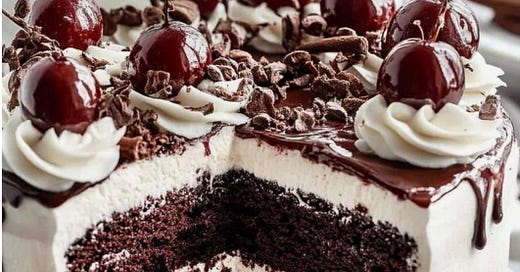



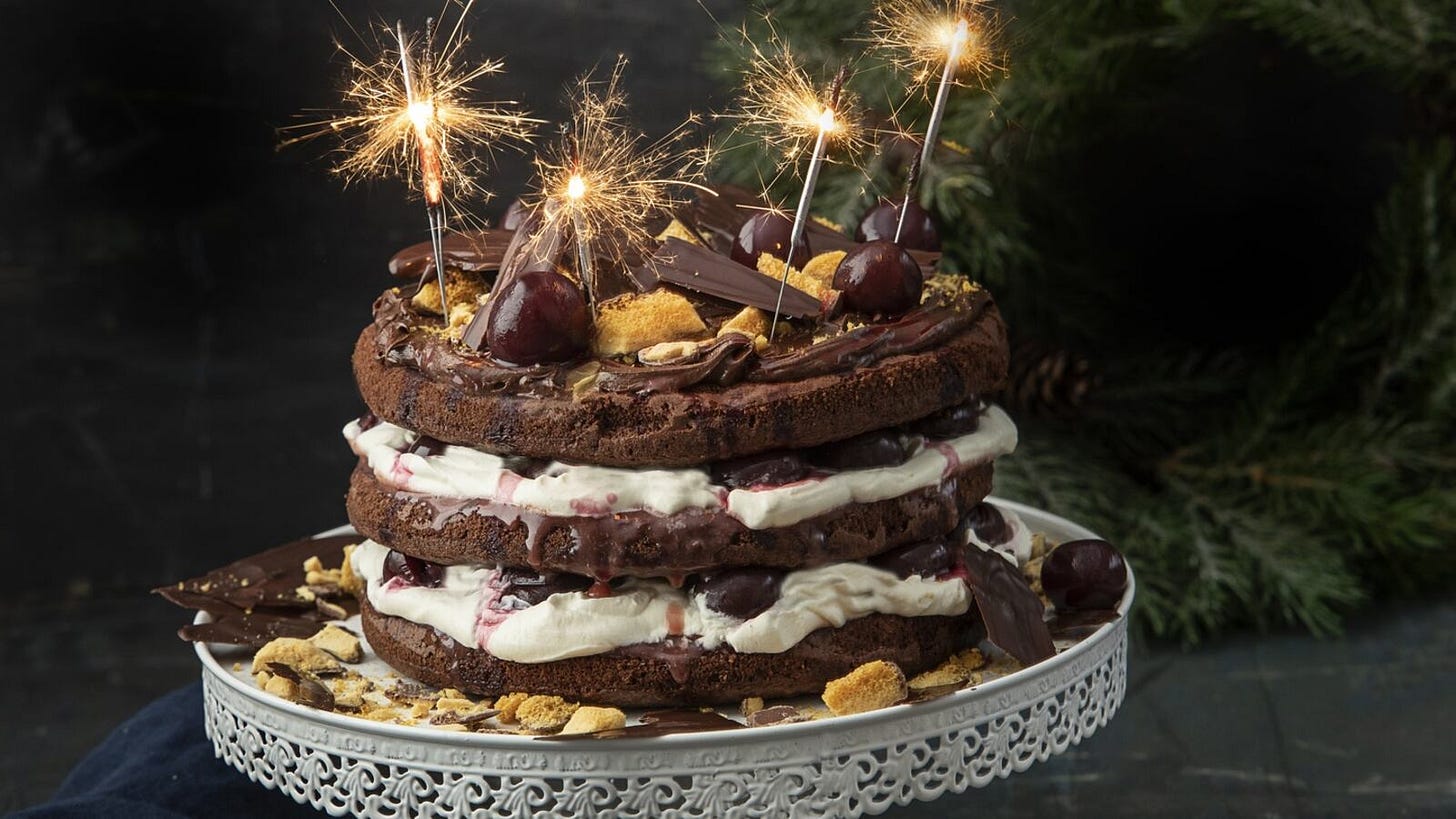

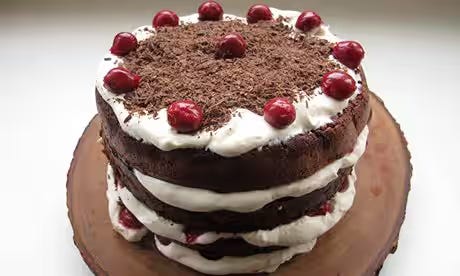
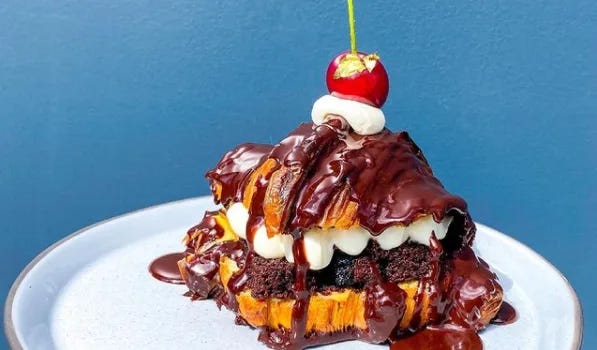
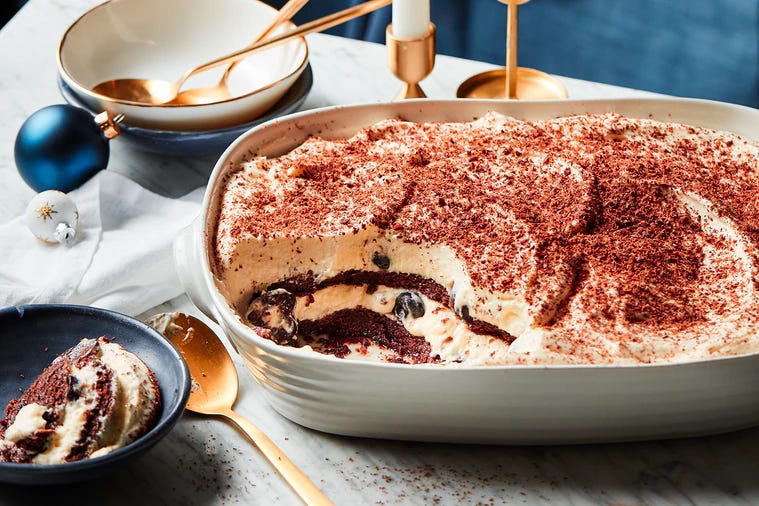
I love Black Forest - we’ve just had a holiday in Germany and I was able to find a gf version there which made me very happy. Readers of a certain age will remember Berni Inns which I thought to be the height of sophistication and always had a Black Forest gateaux on the menu. Yum yum
I do love the Gateaux, but have never attempted to make it myself. Great article